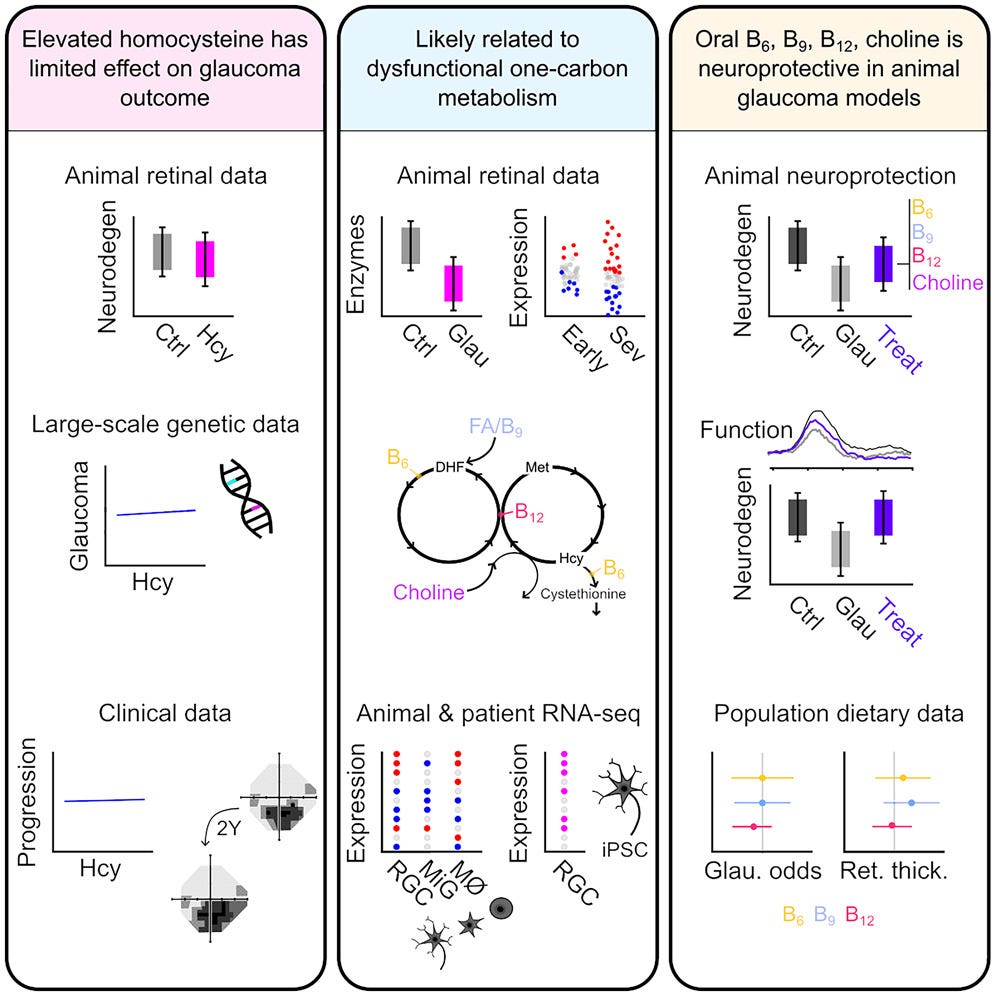Glaucoma optic nerve damage averted with nutrients
Trouble comes from the one-carbon cycle, not the Intra Ocular Pressure
80 million people globally are affected by glaucoma, risking permanent vision loss due to elevated intraocular pressure from an imbalance between the secretion of aqueous humor and the resistance to its flow. It results ultimately in damage to the optic nerve and patterns of visual field deficits from the loss of retinal ganglion cells.
So far, there are no neuroprotective therapies, and reduction of the intraocular pressure (IOP) is the availed strategy. However, some patients develop glaucoma despite a normal IOP and go on to lose their vision. And the pursuit of an ideal “target” IOP can carry risks and negatively impact quality of life.
Glaucoma researchers suspected that the substance, homocysteine, may be relevant to understanding the pathogenesis of this disease. It is part of folate metabolism cycle.

Folates are a family of B9 vitamins necessary for cellular processes such as nucleotide synthesis for cell division and DNA repair, regulation of cellular oxidation and reduction reactions, and epigenetic regulation. Most dietary folates exist in their reduced state, 5-methylTHF, but they are also found as dihydrofolate (DHF), tetrahydrofolate (THF), and others, depending on their place in the folate metabolic pathways.
Homocysteine intersects the methionine cycle and transsulfuration pathway as the precursor for regeneration of L-methionine and generation of L-cysteine. These pathways are important components of one-carbon metabolism, which generates one-carbon units (typically methyl groups) for a variety of metabolic reactions
Experiments determined that homocysteine does not drive glaucoma, but instead is a consequence of it. Altered homocysteine levels may indicate loss of retina’s ability to use certain these vitamins, necessary to maintain healthy metabolism.
Elevated retinal homocysteine is a pathogenic biomarker of glaucoma
One-carbon metabolism is dysregulated in glaucoma
Oral pyridoxine B6, folate B9, cobalamin B12, and choline is neuroprotective in animal models
Glaucoma, characterized by the loss of retinal ganglion cells (RGCs), is a leading cause of blindness for which there are no neuroprotective therapies. To explore observations of elevated homocysteine in glaucoma, we elevate vitreous homocysteine, which increases RGC death by 6% following ocular hypertension. Genetic association with higher homocysteine does not affect glaucoma-associated outcomes from the UK Biobank and serum homocysteine levels have no effect on glaucomatous visual field progression. This supports a hypothesis in which elevated homocysteine is a pathogenic, rather than causative, feature of glaucoma. Further exploration of homocysteine metabolism in glaucoma animal models demonstrates early and sustained dysregulation of genes involved in one-carbon metabolism and the interaction of essential cofactors and precursors (B6, B9, B12, and choline) in whole retina and optic nerve head and RGCs. Supplementing these provides neuroprotection in an acute model and prevents neurodegeneration and protects visual function in a chronic model of glaucoma. - JR Tribble, et al.
In experiments on rodents with glaucoma, researchers supplemented them with the B vitamins pyridoxine B6, folate B9, cobalamin B12, as well as choline, with positive effects. In mice with the slower-developing glaucoma, their optic nerve damage was halted. In rats, with the more aggressive and progressed form of the disease, damage was slowed. Note that the eye pressure was not treated, indicating that the vitamin mix ameliorates the disease separately from pressure regulation.
These data are from animal studies, but human clinical trials are underway, to include both patients with primary open-angle glaucoma (slower progression) and pseudoexfoliation glaucoma (faster progression).
In the meantime, ingesting a diet enriched with B vitamins is a wise health move for those who are at risk or currently suffering from glaucoma.
Related past BioMedWorks newsletters include:
Is retinal regeneration real? Plus related research results. Eye opening info.
Is Vitamin B12 involved in Multiple Sclerosis? What else are cobalamins doing?
REFERENCES
JR Tribble, et al. Dysfunctional one-carbon metabolism identifies vitamins B6, B9, B12, and choline as neuroprotective in glaucoma. Cell Reports Medicine, Volume 6, Issue 5, 102127






Very valuable information, thank you.
Thank you for spotlighting advancements in a field where timely action can truly save vision—looking forward to learning more!